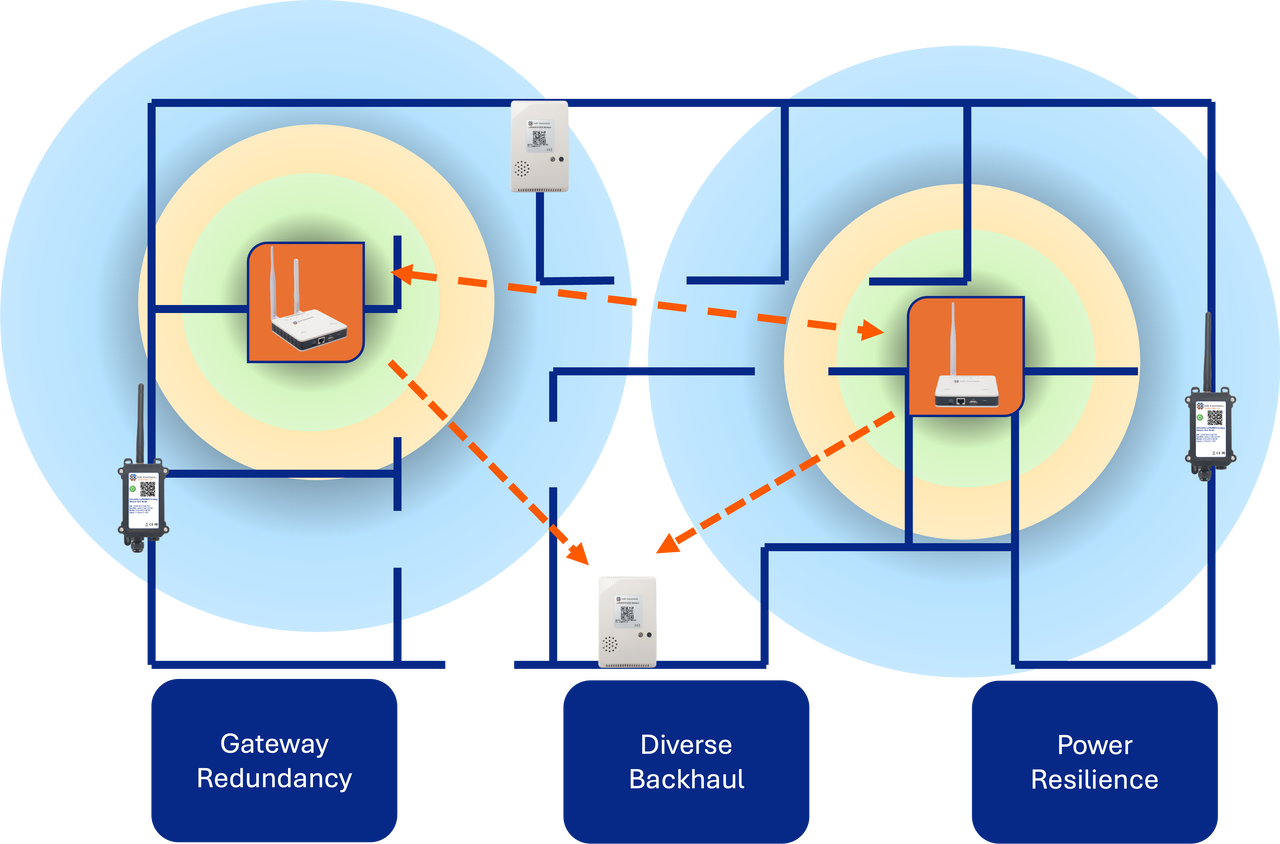In mission-critical environments—such as industrial plants, healthcare facilities, airports, and data centers—connectivity failures are not an option. LoRaWAN technology provides an exceptional foundation for secure, long-range IoT communications, but even the most robust networks can face unexpected outages if redundancy isn’t part of the design.
This article will walk you through the principles of building a redundant LoRaWAN gateway architecture using our Indoor LoRaWAN Ethernet Gateway and best practices from real-world deployments. You’ll also learn how to use our Virtual Site Survey Tool to plan coverage, gateway density, and failover strategies.
Why Redundancy Matters for LoRaWAN Gateways
In mission-critical deployments, a single gateway outage can mean:
-
Missed alarms from water leak sensors in data centers.
-
Lost asset tracking data in logistics hubs.
-
Delayed environmental readings in pharmaceutical storage facilities.
Redundancy ensures that data from your LoRaWAN devices—from environmental sensors to control relays—continues to flow uninterrupted, even if one gateway goes offline.
Key Redundancy Design Principles
1. Dual Gateway Coverage
Always aim for overlapping coverage zones. This way, if one gateway fails or undergoes maintenance, the second gateway can still receive uplinks from your devices.
Tip: Use the Virtual Site Survey Tool to visualize dead zones and determine optimal overlapping placement.
2. Diverse Backhaul Connectivity
Where possible, provision gateways with different network backhauls.
-
Primary: Ethernet or fiber for low-latency, high-reliability connectivity.
-
Secondary: Cellular failover to maintain communication during wired network outages.
3. Separate Power Sources
-
Connect gateways to separate circuits or UPS systems.
-
For critical sites, consider dual power feeds or PoE with backup batteries.
4. Gateway Hardware Selection
Our Indoor LoRaWAN Ethernet Gateway is purpose-built for reliability in commercial settings:
-
High-performance Semtech SX1302/03 concentrator
-
Plug-and-play Ethernet connectivity
-
OTA firmware updates via ioX-Connect
-
Configurable for your regional LoRaWAN frequency plan
View Full Datasheet
5. Gateway Placement Strategy
-
Position gateways to avoid single points of failure from environmental hazards (e.g., avoid placing both in the same equipment room).
-
Factor in physical security to prevent tampering or theft.
Using the Virtual Site Survey Tool for Redundancy Planning
Our LoRaWAN Virtual Site Survey Tool helps you simulate network coverage and identify optimal redundancy points:
-
Search for your site address
-
Add potential gateway locations and simulate coverage zones.
-
Test the effect of a single gateway outage on network reach.
-
Refine placement to ensure full overlap for critical devices.
Example: Data Center Leak Detection Network
Scenario: A Tier III data center needed 24/7 monitoring from industrial water leak rope sensors and environmental devices.
Solution:
-
Deployed two Indoor LoRaWAN Ethernet Gateways on opposite sides of the facility.
-
Configured separate power feeds and network backhauls.
-
Used the Virtual Site Survey Tool to confirm full coverage overlap for all leak detection zones.
Outcome: Zero monitoring downtime during a 3-hour network maintenance window, with full data continuity from all sensors.
Best Practices Checklist
-
Plan for at least two gateways in overlapping coverage.
-
Use diverse network backhauls.
-
Separate power feeds and UPS backups.
-
Use the Virtual Site Survey Tool for placement validation.
-
Schedule regular gateway firmware updates and health checks.
Conclusion
A well-designed redundant LoRaWAN gateway architecture ensures uninterrupted data flow from your IoT devices, safeguarding mission-critical operations against single points of failure.
Whether you’re deploying for a hospital, factory, or data center, pairing robust hardware like the Indoor LoRaWAN Ethernet Gateway with careful redundancy planning—and leveraging the Virtual Site Survey Tool—will set your project up for long-term success.
Topics from this blog: lorawan LoRaWAN IoT LoRaWAN architecture LoRaWAN Gateway

